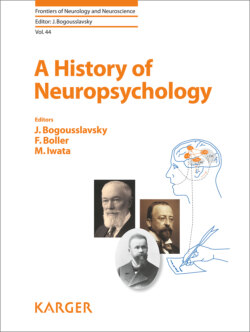Читать книгу A History of Neuropsychology - Группа авторов - Страница 50
На сайте Литреса книга снята с продажи.
Abstract
ОглавлениеIn 1943, Tsuneo Imura, a neuropsychiatrist at Tokyo University, proposed a new aphasic syndrome and designated it as Gogi (word meaning) aphasia. According to Imura, it is characterized by (1) difficulty in comprehending spoken words despite good perception of sound, (2) disorders of expression due to loss of vocabulary and verbal paraphasia, (3) preserved ability of repetition, and (4) selective difficulty in reading and writing kanji (Japanese logographic character) with preserved ability of reading and writing kana (Japanese syllabic character). To be more specific, the difficulty in comprehending spoken words in Gogi aphasia is limited to substantive words as the name of the syndrome indicates, while comprehension of syntax remains unimpaired. Preserved repetition ability cannot be simply regarded as an automatic response, that is, echolalia, because the patient’s attitude in repeating was quizzical, picking up the particular word he did not comprehend. Imura vaguely attributed the responsible lesion to the second and third temporal gyri on the left side. Although the general pattern of the syndrome can be placed in the category of transcortical sensory aphasia, its uniqueness as the syndrome still stands out. Another uniqueness of the syndrome is its characteristic pattern of dissociated kanji-kana difficulty in reading and writing. This linguistic symptomatology observed in Gogi aphasia was first introduced to the western academic world on a German neuropsychiatric journal by Panse and Shimoyama in 1955. Ever since, the existence of Gogi aphasia as an independent syndrome among disorders of spoken language has gradually gained international recognition. But whether the pattern of the kanji-kana dissociation described by Imura is an integral part of the syndrome remains unsettled. A recently proposed concept of semantic dementia suggests symptomatic continuation of word meaning loss with non-linguistic semantic memory loss.
© 2019 S. Karger AG, Basel
In 1943 Tsuneo Imura, a neuropsychiatrist at Tokyo University, reported a new aphasic syndrome which he proposed to be called “Gogi aphasia” in an article published in Japanese [1]. “Go” of “gogi” means word, and “gi” means meaning. He admitted that the syndrome belongs to a broad category of transcortical sensory aphasia but claimed it has a unique characteristic and should be treated as a syndrome. The proposal remained unnoticed outside Japan until 1955 when Imura’s contribution to Japanese aphasiology was introduced along with his concept of “semantische Aphasie” in a German journal as a 2-part article by Panse and Shimoyama [2, 3]. The first part of this article was later translated into English [4]. In 1975, Sasanuma and Monoi [5] published a detailed linguistic study of a case with Gogi aphasia emphasizing the uniqueness of the syndrome because its symptomatology is inherently correlated with the complicated writing system of Japanese. In the article, Imura’s original concept of Gogi aphasia and its later impact on Japanese aphasiology were summarized briefly.
